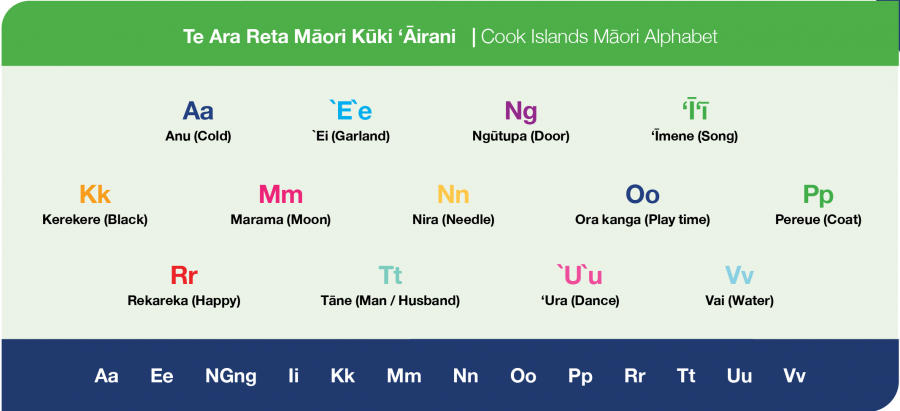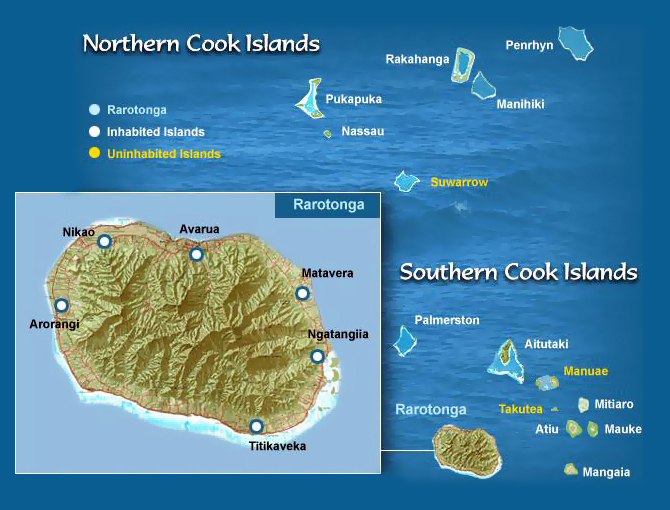

Verkehrssprache: Bezeichnung: Cook-Maori bzw. Maori der Cook-Inseln [Cook Islands Māori (CIM) bzw. Cook Islands Maori/reo māori Kūki ‘Āirani, reo maori Kuki Airani bzw. reo ipukarea] bzw. Maori der Südlichen Cook-Inseln (Southern Cook Island Maori) –
Anmerkungen: umfasst die Varietäten Rarotonganisch, Penrhyn, Pukapukanisch und Rakahanga-Manihiki –
Linguisten der Cook-Maori-Sprachkommission und Cook-Maori-Linguisten in Neuseeland betrachten das Cook-Maori bzw. Maori der Cook-Inseln als eine Sprache bzw. eine Sprache mit mehreren Dialekten, auch wenn diese abweichende Alphabete (und zum Teil abweichende Lexiken etc.) aufweisen (s. u.). Internationale (externe) Linguisten hingegen unterscheiden vier Sprachen: Rarotonganisch, Penrhyn, Pukapukanisch und Rakahanga-Manihiki, daher untenstehende Unterscheidung.[1] –
gesprochen auf den Cook-Inseln[2] –
Sprachfamilie: Austronesisch > Malayo-Polynesisch > Zentral-Ost-Malayo-Polynesisch > Ost-Malayo-Polynesisch > Ozeanisch > Zentral-Ost-Ozeanisch > abgelegenes Ozeanisch > Zentralpazifisch > Ost-Fidschianisch-Polynesisch > Polynesisch > Nuklearpolynesisch > Ost > Zentral > Tahitisch (Austronesian > Malayo-Polynesian > Central-Eastern Malayo-Polynesian > Eastern-Malayo-Polynesian > Oceanic > Central-Eastern Oceanic > Remote Oceanic > Central Pacific > East Fijian-Polynesian > Polynesian > Nuclear > East > Central > Tahitic) –
Dialekte: Aitutaki, Ngāpūtoru (Ātiu, Ma’uke und Miti‘āro), Mangaia, Manihiki und Rakahanga, Rarotonga, Tongareva (Penrhyn) und Pukapuka[3] –
Anerkennung: 2003 anerkannte Amtssprache[4] –
Sprachstatus: EGIDS: Status 6b bedrohte Sprache (threatened) – WAL: gefährdete bzw. unsichere Sprache (endangered/unsafe) – ELP: gefährdete Sprache (endangered)[5] –
Alphabet: Cook-Maori-Alphabet (Cook Islands Māori alphabet/Te ara reta Māori Kūki ‘Āirani bzw. Te au reta o te reo Māori Kūki ’Āirani) bzw. Rarotonganisches Alphabet (Rarotongan alphabet) mit 14 Buchstaben: 12 lateinische Buchstaben, 1 Digraf und kopfstehendes Hochkomma ʻ bzw. Apostroph ‚ bzw.
mit 15 lateinischen Buchstaben mit kopfstehendem Hochkomma ʻ, Apostroph ‚ und/oder Diakritika[6]: (s. o.) –
ISO 639-1-, -2- und -3-Codes: s. Cook-Inseln 🇨🇰 –
Glottocodes: s. Cook-Inseln 🇨🇰 –
Linguasphere-Codes: s. Cook-Inseln 🇨🇰
Bezeichnung: Rarotonganisch (Rarotongan/reo Rarotonga) –
Anmerkungen: gesprochen auf Rarotonga sowie Aitutaki, Atiu, Mangaia, Mauke und Mitiaro –
Linga franca (Sprache) der Kirche[7] –
Sprachfamilie: s. Cook-Maori bzw. Maori der Cook-Inseln –
Dialekte (mit MultiTree-/LINGUIST-Codes): 4 Dialekte: Standarddialekt Rarotonganisch (Rarotongan/reo Rarotonga) (rar-rar), Aitutakianisch (Aitutakian/reo Aitutaki) (rar-ait), Atiuanisch-Maukeanisch-Mitiaroanisch (Atiuan-Maukean-Mitiaroan/‘Ātiu-Ma‘uke-Miti‘āro, Atiu-Mauke-Mitiaro, Ngāpūtoru bzw. Ngaputoru) (rar-ati, rar-mau und rar-mit) und Mangaianisch (Mangaian/reo Mangaia) (rar-man)[8] –
Anerkennung: gesetzlich verankerte Sprache der nationalen Identität (statutory language of national identity) –
Sprachstatus: s. Cook-Maori bzw. Maori der Cook-Inseln –
Alphabet: s. Cook-Maori bzw. Maori der Cook-Inseln –
ISO 639-1-, -2- und -3-Codes: k. Ang., rar, rar[9] –
Glottocode: rar1241[10] –
Linguasphere-Codes: 39-CAQ-b (Rarotonga + Mangaia): 39-CAQ-ba (Rarotonga), 39-CAQ-bb (Mangaia), 39-CAQ-bc (Mauke), 39-CAQ-bd (Aitutaki), 39-CAQ-be (Atiu) und 39-CAQ-bf (Mitiaro)[11]
a e i ng k m n o p r t u v und kopfstehendes Hochkomma ʻ bzw. Apostroph ‚
bzw.
a ‘a ā ‘ā e ‘e ē ‘ē ng i ‘i ī ‘ī k m n o ‘o ō ‘ō p r t u ‘u ū ‘ū v ʻ
[1] Status, Cook Islands, Ethnoloɠue, Languages of the World, SIL International 2016, http://www.ethnologue.com/country/ck/status (aufgerufen am 2016-04-09) und Te Au Reo ‘Enua Tātakita‘i/Dialects (S. 15), Te ‘Āpi‘i‘anga o te Tūranga o te Reo Māori Kūki ‘Āirani/Teaching the Features of Cook Islands Māori, Te Kaveinga o Te Reo Māori Kūki Āirani/The Cook Islands Māori Language Guidelines, Ministry of Education/Te Tāhuhu o te Mātauranga 2012 unter Teaching and learning Cook Islands Māori, Pasifika Education Community, http://pasifika.tki.org.nz/content/download/1679/10135/file/CookIslandMaori_guidelines.pdf (aufgerufen am 2014-12-29)
[2] Languages, Cook Islands, Ethnoloɠue, Languages of the World, SIL International 2016, http://www.ethnologue.com/country/ck/languages (aufgerufen am 2016-04-09)
[3] Te Au Reo ‘Enua Tātakita‘i/Dialects (S. 15), Te ‘Āpi‘i‘anga o te Tūranga o te Reo Māori Kūki ‘Āirani/Teaching the Features of Cook Islands Māori, Te Kaveinga o Te Reo Māori Kūki Āirani/The Cook Islands Māori Language Guidelines, Ministry of Education/Te Tāhuhu o te Mātauranga 2012 unter Teaching and learning Cook Islands Māori, Pasifika Education Community, http://pasifika.tki.org.nz/content/download/1679/10135/file/CookIslandMaori_guidelines.pdf (aufgerufen am 2014-12-29)
[4] Te Kopapa Reo Maori, Te Reo Maori Act 2003 unter Ministry of Cultural Development (MOCD)/Tauranga Vananga 2018, https://www.culture.gov.ck/wp-content/uploads/2018/03/Te-Reo-Maori-Act-2003.pdf (aufgerufen am 2022-10-16)
[5] Status, Cook Islands, Ethnoloɠue, Languages of the World, SIL International 2016, http://www.ethnologue.com/country/ck/status (aufgerufen am 2016-04-09) und Southern Cook Island Maori, Languages, World Atlas of Languages (WAL), UNESCO Atlas of the World’s Endangered Languages, United Nations Educational, Scientific and Cultural Organization (UNESCO) o. J., https://en.wal.unesco.org/languages/southern-cook-island-maori (aufgerufen am 2022-12-16) und Southern Cook Islands Māori, Endangered Language Project (ELP), Catalogue of Endangered Languages (ELCat), University of Hawaiʻi in Mānoa, Honolulu und Eastern Michigan University o. J., https://www.endangeredlanguages.com/lang/2519 (aufgerufen am 2022-07-21)
[6] Arā-reta ‘ē Tōna ‘Akapapa’anga/The Alphabet and Alphabetical Order (S. 14ff.), Te ‘Āpi‘i‘anga o te Tūranga o te Reo Māori Kūki ‘Āirani/Teaching the Features of Cook Islands Māori, Te Kaveinga o Te Reo Māori Kūki Āirani/The Cook Islands Māori Language Guidelines, Ministry of Education/Te Tāhuhu o te Mātauranga 2012 unter Teaching and learning Cook Islands Māori, Pasifika Education Community, http://pasifika.tki.org.nz/content/download/1679/10135/file/CookIslandMaori_guidelines.pdf (aufgerufen am 2014-12-29)
[7] Sermons, Ekalesia Maungarei, CICC Churches, Cook Islands Christian Church (CICC) 2022, https://www.cicc.net.ck/index.php/cicc-churches/13-ekalesia-maungarei (aufgerufen am 2022-11-06) und Sermons, Ekalesia Avarua, CICC Churches, Cook Islands Christian Church (CICC) 2022, https://www.cicc.net.ck/index.php/cicc-churches/3-ekalesia-avarua (aufgerufen am 2022-11-06) und CICC Manual/Te Au Akanoonooanga a te CICC, Cook Islands Christian Church (CICC) Juni 2020, https://www.cicc.net.ck/images/CICC-MANUAL-revised-June-2020.pdf (aufgerufen am 2022-11-06) und Te Puka Pure No Te Akamori’anga E Te Au Akamoro’anga Tapu/CICC Prayer Book for Devotion, Worship and other Sacred Events, Cook Islands Christian Church (CICC) 2011, https://www.cicc.net.ck/images/manuals/cicc-prayer-book-revised-2011.pdf (aufgerufen am 2022-11-06)
[8] Rarotongan, MultiTree.org o. J., http://www.multitree.org/codes/rar.html (aufgerufen am 2020-02-03)
[9] Rarotonga, 639 Identifier Documentation: rar, SIL International 2020, https://iso639-3.sil.org/code/rar (aufgerufen am 2020-01-29)
[10] Spoken L1 Language: Southern Cook Island Maori, Glottolog, Max Planck Institute for Evolutionary Anthropology o. J., https://glottolog.org/resource/languoid/id/raro1241 (aufgerufen am 2020-01-29)
[11] Austronesian phylosector, Linguaspere Register, hortensj-garden.org o. J., http://www.hortensj-garden.org/index.php?tnc=1&tr=lsr&nid=3%3D&lr=t (aufgerufen am 2020-01-22)
Bildquelle/n:
- Grafik: Cook-Maori-Alphabet: Ministry for Pacific Peoples/Te Manatū mō Ngā Iwo o Te Moana-nui-a-Kiwa (zugeschnitten von Sebastian BECKER) | CC BY 4.0 International
- Karte: Inseln und Sprachen bzw. Dialekte der Cook-Inseln: Vidiani.com | CC BY-SA 3.0 Unported
- Logo: Apple App Store: Heise RegioConcept | All Rights Reserved
- Logo: Google Play Store: Heise RegioConcept | All Rights Reserved


Neueste Kommentare